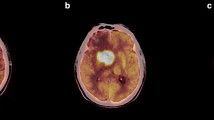Abstract
Objective
Faint brain [18F]fluoro-2-deoxyglucose (FDG) uptake has sporadically been reported in patients with FDG-avid large or diffusely extended tumors. The purpose of this study was to investigate whether there is a correlation between massive tumor uptake and decreased brain uptake on FDG positron emission tomography/computed tomography (PET/CT).
Methods
Sixty-five patients with histologically confirmed non-Hodgkin’s lymphoma who underwent FDG-PET/CT were enrolled. Thirty control subjects were also included to evaluate normal brain FDG uptake. PET/CT examinations were retrospectively reviewed. The volumetric regions of interest were placed over lesions by referring to CT and PET/CT fusion images to measure mean standardized uptake value (SUVavg). The products of SUVavg and tumor volume were calculated as total glycolytic volume (TGV). The maximum SUV (SUVmax) and SUVavg were measured in the cerebrum and cerebellum. The values of TGV and brain FDG uptake were plotted and analyzed with a linear regression method.
Results
In the lymphoma patients, there were statistically significant negative correlations between TGV and brain SUVs.
Conclusion
Demonstrating a significant negative correlation between TGV and brain uptake validated the phenomenon of decreased brain FDG uptake. Diversion of FDG from the brain to the lymphoma tissue may occur during the FDG accumulation process. Recognition of this phenomenon prevents unnecessary further neurological examinations in such cases.






Similar content being viewed by others
References
Basu S, Nair N. Unusually elevated liver radioactivity on F-18 FDG PET in Hodgkin’s disease: hepatic ‘superscan’. Clin Nucl Med. 2004;29:626–8.
Paone G, Itti E, Haioun C, Gaulard P, Dupuis J, Lin C, et al. Bone marrow involvement in diffuse large B-cell lymphoma: correlation between FDG-PET uptake and type of cellular infiltrate. Eur J Nucl Med Mol Imaging. 2008;36:745–50.
Su HY, Liu RS, Liao SQ, Wang SJ. F-18 FDG PET superscan. Clin Nucl Med. 2006;31:28–9.
Allen-Auerbach M, de Vos S, Czernin J. The impact of fluorodeoxyglucose-positron emission tomography in primary staging and patient management in lymphoma patients. Radiol Clin North Am. 2008;46:199–211.
Juweid ME. 18F-FDG PET as a routine test for posttherapy assessment of Hodgkin’s disease and aggressive non-Hodgkin’s lymphoma: where is the evidence? J Nucl Med. 2008;49:9–12.
Juweid ME, Cheson BD. Role of positron emission tomography in lymphoma. J Clin Oncol. 2005;23:4577–80.
Juweid ME, Stroobants S, Hoekstra OS, Mottaghy FM, Dietlein M, Guermazi A, et al. Use of positron emission tomography for response assessment of lymphoma: consensus of the Imaging Subcommittee of International Harmonization Project in Lymphoma. J Clin Oncol. 2007;25:571–8.
Larson SM, Erdi Y, Akhurst T, Mazumdar M, Macapinlac HA, Finn RD, et al. Tumor treatment response based on visual and quantitative changes in global tumor glycolysis using PET-FDG imaging. The visual response score and the change in total lesion glycolysis. Clin Positron Imaging. 1999;2:159–71.
Guillem JG, Moore HG, Akhurst T, Klimstra DS, Ruo L, Mazumdar M, et al. Sequential preoperative fluorodeoxyglucose-positron emission tomography assessment of response to preoperative chemoradiation: a means for determining longterm outcomes of rectal cancer. J Am Coll Surg. 2004;199:1–7.
Francis RJ, Byrne MJ, van der Schaaf AA, Boucek JA, Nowak AK, Phillips M, et al. Early prediction of response to chemotherapy and survival in malignant pleural mesothelioma using a novel semiautomated 3-dimensional volume-based analysis of serial 18F-FDG PET scans. J Nucl Med. 2007;48:1449–58.
Tanaka C, Ueguchi T, Shimosegawa E, Sasaki N, Johkoh T, Nakamura H, et al. Effect of CT acquisition parameters in the detection of subtle hypoattenuation in acute cerebral infarction: a phantom study. Am J Neuroradiol. 2006;27:40–5.
Pauwels EK, Ribeiro MJ, Stoot JH, McCready VR, Bourguignon M, Maziere B. FDG accumulation and tumor biology. Nucl Med Biol. 1998;25:317–22.
Wong CY, Thie J, Gaskill M, Ponto R, Hill J, Tian HY, et al. A statistical investigation of normal regional intra-subject heterogeneity of brain metabolism and perfusion by F-18 FDG and O-15 H2O PET imaging. BMC Nucl Med. 2006;6:4.
Kemppainen J, Aalto S, Fujimoto T, Kalliokoski KK, Lângsjö J, Oikonen V, et al. High intensity exercise decreases global brain glucose uptake in humans. J Physiol. 2005;568:323–32.
Dalsgaard MK. Fuelling cerebral activity in exercising man. J Cereb Blood Flow Metab. 2006;26:731–50.
Acknowledgments
The authors thank Prof. Tetsuo Ito and Prof. Nobuyuki Sugiura and Dr. Rina Ando for scientific advice, Tatsuro Uto, Hideo Morimoto, Hiroshi Takada, Kenta Sakaguchi, and Akiko Oohata for assistance in data acquisition. This work was supported by “Collaboration with Local Communities” Project: matching fund subsidy for Private Universities from Ministry of Education, Culture, Sports, Science and Technology, Japan.
Author information
Authors and Affiliations
Corresponding author
Rights and permissions
About this article
Cite this article
Hanaoka, K., Hosono, M., Shimono, T. et al. Decreased brain FDG uptake in patients with extensive non-Hodgkin’s lymphoma lesions. Ann Nucl Med 24, 707–711 (2010). https://doi.org/10.1007/s12149-010-0415-5
Received:
Accepted:
Published:
Issue Date:
DOI: https://doi.org/10.1007/s12149-010-0415-5




